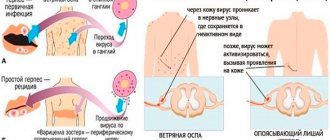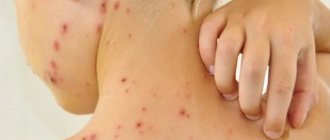Today, human papillomavirus (HPV) is one of the most common viral infections. According to statistics, it is present in almost 90% of the world's population. Scientists have also proven that two types of the virus (16 and 18) occur in approximately 70% of patients diagnosed with cervical cancer and precancerous pathological conditions of the cervix.1 It has been established that in women with long-term persistence of the virus in the body, the risk of developing cervical cancer increases 80 times. For this reason, doctors pay increased attention to the fight against this disease.
- Types of virus that can cause cancer
- Varieties of the virus
- Viferon suppositories for HPV Release form and composition
- Indications for use
- Suppository dosages
- Use during pregnancy
Human papillomavirus (HPV) belongs to the genus Papillomavirus and belongs to subgroup A of the Papovaviridae family. It inhabits the deep layers of the epithelium (skin and mucous membranes), and its reproduction occurs in the upper layers of the epithelium. The entire life cycle of the virus takes place only inside the cells of the body, but for some time it can also exist in the external environment, which explains its high contagiousness - the ability of infectious diseases to be transmitted from sick people to healthy people by transmitting the pathogen through direct contact or through transmission factors. Re-infection is possible because immunity to this virus is not developed.
Types of HPV with oncogenic risk
Currently, there are more than 600 types (strains) of papillomavirus found in humans. Of these, approximately 40 can cause damage to the anogenital tract of men and women, which is manifested by the formation of condylomas or the development of precancerous changes within the epithelium with the subsequent development of cancer of the cervix, vagina, vulva, anus, and penis.
All types of papillomaviruses are divided into three groups according to their oncogenic danger to humans1:
- human papillomaviruses of low oncogenic risk: 6, 11, 40, 42, 43, 44;
- viruses of intermediate oncogenic risk: 35, 51, 52, 58;
- viruses of high oncogenic risk: 16, 18, 31, 33, 45, 56.
The oncogenicity of the virus is explained by its ability to integrate its DNA into the genome of human cells.
Possible complications
Human papillomavirus infection can cause severe or mild complications. The most severe possible complication is the development of malignant tumors. Oncogenic strains of the virus cause cellular mutations that contribute to the transformation of benign tumors into malignant ones.
Cervical dysplasia precedes the development of cancer. Papillomas on the larynx grow and cause attacks of suffocation. HPV increases the likelihood of cancer of the stomach, intestines, and respiratory system.
Benign formations on the skin seem less dangerous than cancer. But we do not recommend delaying their treatment. Condylomas, papillomas and warts can accidentally come off. In their place, a bleeding wound forms, into which pathogenic microorganisms easily penetrate. Large defects can leave unsightly scars if the removal is not carried out in the office of a dermatovenerologist.
Intraurethral condylomas may be accompanied by inflammation and bleeding from the urethra.
What types of HPV exist?
HPV infection of anogenital localization can occur in latent, subclinical and clinical forms. In the latent form, the virus is detected, but there are no changes in the epithelium. Subclinical infection is detected only using a test with 3% acetic acid and manifests itself as small flat warts. The clinical form of human papillomavirus infection can occur in the form of intraepithelial lesions (within the epithelium) in women and men, which are not visible to the naked eye, but are detected by colposcopy and cytological/histological examination and can lead to precancerous diseases and cancer. And also in the form of genital warts, which are soft papillary formations on a stalk, prone to fusion. Merging, they form colonies that look like cauliflower.
The manifestations of human papillomavirus are variable and depend on the type of virus. HPV of low oncogenic risk also leads to the appearance of warts and papillomas:
- Vulgar warts are hard growths more than 1 mm in diameter with a rough, keratinized surface. It is possible for papillomas to merge to form large areas of damage.
- Plantar warts are hard, flat formations on the skin of the foot, rising above its level and covered with a layer of keratinized epithelium. They have a protruding rim. Sometimes one wart produces daughter warts.
- Flat warts are skin formations in the form of flat nodules up to 5 mm in size. Flat warts, as a rule, are multiple and are located in groups on the face, back of the hands, and legs.
- Threaded papillomas affect the area around the eyes, groin, neck and armpits. They are elongated formations of elastic consistency measuring 5-6 mm.
There are three known routes of transmission of HPV:
- contact and household;
- sexual (genital, anal, oral-genital);
- in childbirth from mother to child.
Predisposing factors that contribute to infection and the development of infection are vitamin deficiency, immunodeficiency, smoking, endometriosis, physical overload and chronic fatigue, pregnancy, urogenital infections, as well as any chronic diseases that negatively affect the immune system. The risk of infection increases with frequent contact with bare human skin, for example during massage.
Classification of viral strains
All HPV strains are divided into cutaneous and mucosotropic. Skin viruses lead to the formation of benign tumors on the skin. Mucosotropic provoke the appearance of neoplasms on the mucous membranes.
Skin strains provoke the development of different types of papillomas:
- Flat. Round nodules with a diameter of up to 10 mm. They do not turn into cancer.
- Pointed. Shaped like a cockscomb. These are pink formations covered with horny cells.
- Thread-like. Round papillomas on a thin stalk. Diameter up to 7 mm.
Mucosotropic strains cause the following diseases:
- Bowenoid papulosis. The appearance of spots and plaques on the genitals.
- Dysplasia. Pathological degeneration of cervical tissue.
- Inguinal condylomas. Ball-shaped tumors on a stalk.
If benign tumors appear, you should consult a doctor. A dermatovenerologist will determine the type of papillomavirus and the degree of its danger, and prescribe a treatment regimen for the infection.
VIFERON Suppositories for HPV
Since infection with the virus and the appearance of papillomas and condylomas on the skin and mucous membranes are inextricably linked with the state of the immune system, treatment when the human papillomavirus is detected in the body includes drugs that not only fight viruses, but also help restore immunity. One of these drugs is VIFERON, which has a wide spectrum of antiviral activity and strengthens the immune system. Recombinant interferon alpha-2b, which is part of this drug, has immunomodulatory, antiviral properties (blocks virus replication) and helps restore the immune system. It is identical to human interferon alpha-2b, but is produced using modern technology without the use of donor blood.
Release form and composition
The drug, which is available in the form of suppositories, gel and ointment, was developed as a result of fundamental research in the field of immunology, which has proven that in the presence of antioxidants (vitamins C, E), the antiviral effect of interferon is enhanced.
VIFERON Suppositories are produced in the form of bullet-shaped rectal suppositories of white-yellow or yellow color. The drug suppresses the activity of viruses and increases the effectiveness of the body's own immune response to pathogenic microorganisms. Cocoa butter, which is part of the drug, contains phospholipids, due to which the medicinal substances are evenly distributed throughout the suppository, which ensures their rapid and almost 100% entry into the blood. Unlike cocoa powder, butter does not contain natural allergens and does not irritate the mucous membrane. The properties of cocoa butter make it possible to avoid the need to add synthetic toxic emulsifiers, which, in the case of using solid fat as the basis of suppositories, are used to uniformly distribute and increase the bioavailability (absorption) of the active substance.
Indications for use for HPV
The drug in the form of suppositories can be used during pregnancy (from the 14th week), as well as during breastfeeding and when treating children.
The drug is used in children and adults as part of complex therapy to combat a number of diseases, including infectious and inflammatory diseases of the urogenital tract in adults (human papillomavirus, chlamydia, cytomegalovirus infection, ureaplasmosis, trichomoniasis, gardnerellosis, bacterial vaginosis, recurrent vaginal candidiasis, mycoplasmosis). It reduces the frequency of relapses and prevents the progression of cervical pathology associated with HPV infection.
VIFERON suppositories for HPV: drug dosage
Information on how to use VIFERON Suppositories for human papillomavirus is contained in the instructions. The recommended dose for adults is VIFERON 500,000 IU, 1 suppository 2 times a day after 12 hours every day for 5-10 days. According to clinical indications, therapy can be continued.
Before using suppositories, check their expiration date. It is not recommended to use candles that have expired. Before using a rectal suppository, you should wash your hands thoroughly. The candle wrapper must be carefully cut with scissors and its contents removed. Then you need to lie on any side convenient for the procedure, completely straightening your lower leg and bending your upper leg towards your stomach. Then you need to slowly insert the suppository into the anus, pushing it past the muscle sphincter with the tip of your finger. After inserting the suppository, the buttocks should be brought together and held in this position for several seconds.
The use of Viferon suppositories against HPV during pregnancy
Pregnant women from the second trimester of pregnancy (starting from the 14th week of gestation) are prescribed VIFERON 500,000 IU, 1 suppository 2 times a day every 12 hours daily for 10 days, then for 9 days 3 times with an interval of 3 days (on the fourth day) 1 suppository 2 times a day after 12 hours. Then every 4 weeks until delivery - the drug in a dosage of 150,000 IU, 1 suppository 2 times a day every 12 hours every day for 5 days. If necessary, the drug is prescribed before delivery (from the 38th week of gestation) at a dosage of 500,000 IU, 1 suppository 2 times a day after 12 hours every day for 10 days.
Advantages of the Private Practice Clinic
- Certification in all areas of work.
- The consultation is conducted by experienced dermatovenerologists and gynecologists.
- The latest methods of treating diseases.
- Possibility of removing papillomas and condylomas using all currently known modern methods without pain and serious scars.
- Results of express tests on the day of treatment.
- Individual approach to each patient.
- Polite and friendly staff.
- You can undergo diagnosis and treatment anonymously.
- Convenient location of the clinic in the center of Moscow and Southern Administrative District.
- Parking for visitors to the medical center.
Truths and myths about human papillomavirus
FACT 1. Human papillomavirus can cause cervical pathology in the form of precancerous changes and cervical cancer.
This is true. Certain types of virus can cause serious health problems. The virus is found in most patients with cervical cancer. Human papillomavirus of medium and low oncogenic risk leads to the appearance of condylomas, papillomas and warts throughout the body and genitals. These lesions are not precancerous and require treatment for cosmetic reasons.
FACT 2: Condoms and other barrier contraceptives protect against HPV transmission.
It is a myth. Of course, using condoms reduces the risk of contracting the virus, but they are not able to completely protect against infection. Especially in cases where formations in the intimate area are located outside the organs protected by the contraceptive.2
FACT 3. The presence of human papillomavirus in the body is determined by a blood test for antibodies.
It is a myth. Antibodies in the blood can be detected as evidence that the body has previously encountered HPV. The virus itself can only be detected in squamous epithelial cells, which are present on the mucous membranes and skin.
FACT 4. You can completely get rid of the human papillomavirus.
It is a myth. At the moment, there is no method of combating the virus that would permanently eliminate it from the body. However, the manifestations of the virus can be successfully combated with a course of treatment with immunomodulatory drugs with antiviral activity, including the drug VIFERON.1,2
FACT 5. Human papillomavirus can disappear on its own without treatment.
This is true. This phenomenon is called “self-elimination”, which is possible within 6-24 months after infection, as a consequence of an adequate immune response. Most often it happens to women under 26-30 years of age.2 After 30 years, the likelihood of self-healing decreases significantly and the majority remain carriers of the human papillomavirus.
Reference and information material
Author of the article
Belyaev Dmitry Alexandrovich
General doctor
Sources
1. Early pregnancy. From prenatal preparation to healthy gestation” / Ed. V.E. Radzinsky and A.A. Orazmuradova. – 3rd ed., revised. and additional – M.: Editorial office of the magazine StatusPraesens, 2018. – 800 p.
2. Gynecology: national guide / ed. G.M. Savelyeva, T.G. Sukhikh, V.N. Serova, I.B. Manukhina, V.E. Radzinsky. M.: GEOTAR-Media, 2022. – 1008 p.
Loading...
Take other surveys
special instructions
The drug should not be used for generalized or atypical herpetic infections. Since the medicine can cause an allergic reaction, it is not prescribed for atopic dermatitis or eczematous rashes. The drug is not recommended for:
- tumor processes on the skin,
- familial pemphigus Gougereau-Hailey,
- mental disorders,
- simultaneous use of sedative drugs,
- neutropenia less than 1.5×109,
- the platelet count in the blood is less than 90,000/µl,
- diseases in which there is a disruption of the central nervous system.









